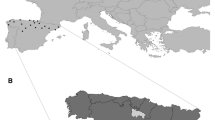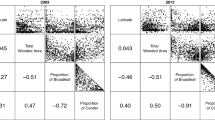Abstract
The relationships between the wild boarSus scrofa, Linnaeus 1758 density and the habitat characteristics were investigated by collecting bag records in 18 hunting areas during the 1995 and 1996 hunting seasons. The study areas were located in the Northern Apennines (N-Italy) from 470 to 1160 m a.s.l. In each study area a Density Index (DI) was calculated by weighting the number of wild boar culled in each hunting season on the number of hunting days and on the surface of the study areas. Moreover 16 habitat variables were measured in each study area. Correlation and regression analyses were performed considering the DI as a dependent variable. Mixed deciduous woods were positively correlated with wild boar density together with chestnuts woods and conifer reafforestations. No significant negative correlations were found. Twelve multiple regression models each including three habitat variables were ranked by the information-theoretic approach (modified Akaike’s information criterion). The study stressed the importance of mixed woods for wild boar and the usefulness of hunting data as a mean to predict the habitat suitability for the species.
Similar content being viewed by others
References
Acevedo P., Escudero M. A., Muńoz R. and Gortázar C. 2006. Factors affecting wild boar abundance across an environmental gradient in Spain. Acta Theriologica 51: 327–336.
Anderson D. R. and Burnham K. P. 2002. Avoiding pitfalls when using Information-theoretic methods. The Journal of Wildlife Management 66: 912–918.
Anderson D. R., Burnham K. P. and Thompson W. L. 2000. Null hypothesis testing: problems, prevalence, and an alternative. The Journal of Wildlife Management 64: 912–923.
Anderson D. R., Link W. A., Johnson D. H. and Burnham K. P. 2001. Suggestions for presenting the results of data analyses. The Journal of Wildlife Management 65: 373–378.
Bissonette J. A. 1999. Small sample size problems in wildlife ecology: a contingent analytical approach. Wildlife Biology 5: 65–71.
Boitani L. and Mattei L. 1992. Aging wild boar (Sus scrofa) by tooth eruption. [In: Ongulés/Ungulates 91. F. Spitz, G. Janeau, G. Gonzales and S. Aulaugnier, eds]. S.F.E.P.M.-I.R.G.M., Toulouse: 419–421.
Boitani L., Mattei L., Nonis D. and Corsi F. 1994. Spatial and activity patterns of wild boar in Tuscany, Italy. Journal of Mammalogy 75: 600–612.
Boitani L., Trapanese P. and Mattei L. 1995. Methods of population estimates of a hunted wild boar (Sus scrofa L.) population in Tuscany, Italy. Ibex —; Journal of Mountain Ecology 3: 197–201.
Brandt S., Jullien J. M. and Vassant J. 1988. Peut on estimer l’effectif d’une population de sangliers par relevé d’empreintes sur la neige? Bulletin Mensuel O.N.C. 122: 21–27.
Brangi A. and Meriggi A. 2003. Wild boar (Sus scrofa) spreading and crop damage in an area of western Prealps. Hystrix 14: 95–105. [In Italian with English summary]
Braza F. and Alvarez F. 1988. Utilisation de l’habitat et organisation sociale du sanglier (Sus scrofa L.) a Doñana (Sud-Ouest de l’Espagne). Canadian Journal of Zoology 67: 2047–2051.
Burnham K. P. and Anderson D. R. 2002. Model selection and multi-model inference. A practical information-theoretic approach. 2nd Edition. Springer-Verlag. New York: 1–488.
Cargnelutti B., Gerard J. F., Spitz F., Valet G. and Sardin T. 1990. Occupation par le sanglier (Sus scrofa) des habitats d’un agro-écosystème modifié lors de la méchanisation de l’agriculture. Gibier Faune Sauvage 7: 53–66.
Caughley G. 1977. Analysis of vertebrate populations. John Wiley and Sons, New York: 1–234.
Epperson B. K. 2000. Spatial and space-time correlations in ecological models. Ecological Modelling 132: 63–76.
Fernandez-Llario P. and Mateos-Quesada P. 2003. Population structure of the wild boar (Sus scrofa) in two Mediterranean habitats in the western Iberian Peninsula. Folia Zoologica 52: 143–148.
Focardi S., Toso S. and Pecchioli E. 1996. The population modelling of fallow deer and wild boar in a Mediterranean ecosystem. Forest Ecology and Management 88: 7–14.
Fournier-Chambrillon C., Maillard D. and Fournier P. 1996. Variabilitè du règime alimentaire du sanglier (Sus scrofa L.) dans les garrigues de Montpellier (Hèrault). Gibier Faune Sauvage 13: 1457–1476.
Genov P. 1981. Food composition of Wild Boar in North-eastern and Western Poland. Acta Theriologica 26: 185–205.
Gerard J. E., Cargnelutti B., Spitz F., Valet G. and Sardin T. 1991. Habitat use of wild boar in a French agroecosystem from late winter to early summer. Acta Theriologica 36: 119–129.
Groot Bruinderink G. W. T. A. and Hazebroek E. 1996. Wild boar (Sus scrofa scrofa L.) rooting and forest regeneration on podzolic soils in the Netherlands. Forest Ecology and Management 88: 71–80.
Hansen L. P., Nixon C. M. and Loomis F. 1986. Factors affecting daily and annual harvest of white-tailed deer in Illinois. Wildlife Society Bulletin 14: 368–376.
Helldin J-O. 2000. Population trends and harvest management of pine marten Martes martes in Scandinavia. Wildlife Biology 6: 111–120.
Holsworth W. N. 1973. Hunting efficiency and white-tailed deer density. The Journal of Wildlife Management 37: 336–352.
Kendall B. E. and Fox G. A. 1998. Spatial structure, environmental heterogeneity, and population dynamics: analysis of the coupled logistic map. Theoretical Population Biology 54: 11–37.
Krebs C. J., Cilbert B. S. and Boutin S. 1986. Population biology of snowshoe hares. I. Demography of food-supplemented populations in the Southern Yukon. 1976-84. Journal of Animal Ecology 55: 963–982.
Leeuwenberg F. and Hepburn I. (eds) 1982. Working Group on Game Statistics: proceedings of the 2nd Meeting, Doorwerth, 6–7 October 1982. International Union of Game Biologists, Zoetermer, Netherlands: 1–147.
Massei G. and Genov P. 2000. [The wild boar]. Calderini Edagricole, Bologna: 1–189. [In Italian]
Massei G., Genov P. and Staines B. W. 1996. Diet, food availability and reproduction of wild boar in a Mediterranean coastal area. Acta Theriologica 41: 307–320.
Massei G., Genov P., Staines B. W. and Gorman M. L. 1997. Factors influencing home range and activity of wild boar (Sus scrofa) in a Mediterranean coastal area. Journal of Zoology, London 242: 411–423.
Massolo A. and Meriggi A. 1998. Factors affecting habitat occupancy by wolves in the Northern Apennines (northern Italy): a model of habitat suitability. Ecography 21: 97–107.
Mattioli L., Apollonio M., Lovari C., Siemoni N. and Crudele G. 1995. Wild boar as the main prey species of wolf in an area of the Northern Apennines (Italy). Ibex — Journal of Mountain Ecology 3: 212.
McDonald R. A. and Harris S. 1999. The use of trapping records to monitor populations of stoatsMustela erminea and weaselsMustela nivalis: the importance of trapping effort. Journal of Applied Ecology 36: 679–688.
Meriggi A. and Lovari S. 1996. A review of wolf predation in Southern Europe: does the wolf prefer wild prey to livestock? Journal of Applied Ecology 33: 1561–1571.
Meriggi A. and Sacchi O. 1992. Factors affecting damage by wild boar to cereal fields in Northern Italy. [In: Ongulés/ Ungulates 91. F. Spitz, G. Janeau, G. Gonzales and S. Aulaugnier, eds]. S.F.E.P.M.-I.R.G.M., Toulouse: 439–441.
Meriggi A. and Sacchi O. 2001. Habitat requirements of wild boar in the Northern Apennines (N Italy): a multi-level approach. Italian Journal of Zoology 68: 47–55.
Meriggi A., Brangi A., Matteucci C. and Sacchi O. 1996. The feeding habits of wolves in relation to large prey availability in Northern Italy. Ecography 19: 287–295.
Motta R. 1996. Impact of wild ungulates on forest regeneration and tree composition of mountain forest in the Western Italian Alps. Forest Ecology and Management 88: 93–98.
Roseberry J. L. and Woolf A. 1991. A comparative evaluation of techniques for analyzing white-tailed deer harvest data. Wildlife Monographs 117: 1–59
Rushton S. P., Ormerod S. J. and Kerby G. 2004. New paradigms for modelling species distribution? Journal of Applied Ecology 41: 193–200.
Saez-Royuela C. and Telleria J. L. 1988. Las batidas como método de censo en especies de caza mayor: aplicacion al caso del jabalè (Sus scrofa L.) en la provincia de Burgos (Norte España). Doñana Acta Vertebrata 15: 215–223.
Schley L. and Roper T. J. 2003. Diet of wild boarSus scrofa in Western Europe, with particular reference to consumption of agricultural crops. Mammal Review 33: 43–56.
Singer F. J., Otto D. K., Tipton A. R. and Hable C. P. 1981. Home ranges, movements and habitat use of European wild boar in Tennessee. The Journal of Wildlife Management 45: 343–353.
Spitz F. and Janeau G. 1990. Spatial strategies: an attempt to classify daily movements of wild boar. Acta Theriologica 35: 129–149.
Spitz F. and Leck S. 1999. Environmental impact prediction using neural network modelling. An example in wildlife damage. Journal of Applied Ecology 36: 317–326.
Valet G., Rosell C., Chayron L., Fosty P. and Spitz F. 1994. Règime alimentaire automnal du sanglier (Sus scrofa) en Ariège, France, et en Catalogne, Espagne. Gibier Faune Sauvage 11: 313–326.
Vassant J. and Breton D. 1986. Essai de rèduction de dégâts de sangliers sur le blé (Triticum aestivum) au stade laiteux par distribution de mais (Zea mais) en foret. Gibier Faune Sauvage 3: 83–95.
Author information
Authors and Affiliations
Additional information
Associate Editor was Krzysztof Schmidt.
Rights and permissions
About this article
Cite this article
Merli, E., Meriggi, A. Using harvest data to predict habitat-population relationship of the wild boarSus scrofa in Northern Italy. Acta Theriol 51, 383–394 (2006). https://doi.org/10.1007/BF03195185
Received:
Accepted:
Issue Date:
DOI: https://doi.org/10.1007/BF03195185




